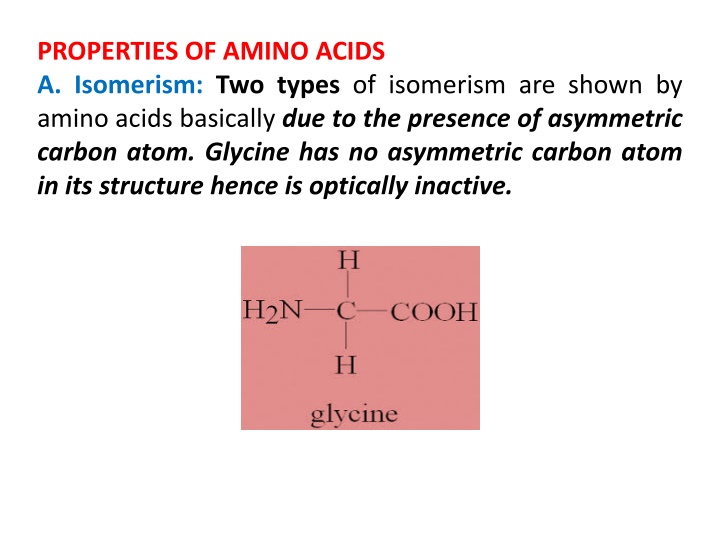
Amino Acids Properties Overview: Isomerism, Amphoteric Nature, Physical & Chemical Properties
Discover the key properties of amino acids, including isomerism, amphoteric nature, isoelectric pH, physical properties like solubility and melting point, and chemical properties like ester formation. Understand the structural and functional characteristics that make amino acids essential building blocks in biological systems.
Download Presentation

Please find below an Image/Link to download the presentation.
The content on the website is provided AS IS for your information and personal use only. It may not be sold, licensed, or shared on other websites without obtaining consent from the author. If you encounter any issues during the download, it is possible that the publisher has removed the file from their server.
You are allowed to download the files provided on this website for personal or commercial use, subject to the condition that they are used lawfully. All files are the property of their respective owners.
The content on the website is provided AS IS for your information and personal use only. It may not be sold, licensed, or shared on other websites without obtaining consent from the author.
E N D
Presentation Transcript
PROPERTIES OF AMINO ACIDS A. Isomerism: Two types of isomerism are shown by amino acids basically due to the presence of asymmetric carbon atom. Glycine has no asymmetric carbon atom in its structure hence is optically inactive.
(a) Stereoisomerism: All amino acids except glycine exist in D and L isomers. In D-amino acids NH2 group is on the right hand while in L-amino acids it is oriented to the left.
Natural proteins of animals and plants generally contain L-amino acids. D-amino acids occur in bacteria.
B. Amphoteric Nature and Isoelectric pH: The -NH2 and -COOH groups of amino acids are ionizable groups. Further, charged polar side chains of few amino acids also ionise. Depending on the pH of the solution these groups act as proton donors (acids) or proton acceptors (bases).
This property is called as amphoteric and therefore amino acids ampholytes. are called as At a specific pH the amino acid carries both the charges in equal number and exists as dipolar ion or Zwitterion . At this point the net charge on it is zero
The pH at which amino acid occurs without any charge on it is called pI or isoelectric pH. On the acidic side of its pI amino acids exist as a cation by accepting a proton and on alkaline as anion by donating a proton.
C. Physical Properties: They are Colorless Crystalline substances more soluble in water than in polar solvents They have high melting point usually more than 200 C. They have a high dielectric constant. They possess a large dipole moment.
D. Chemical Properties I. Due to Carboxylic ( COOH) Group 1. Formation of esters: They can form esters with alcohols. The COOH group can be esterified with alcohol.
2.Reduction to amino alcohol: This is achieved in presence of lithium aluminium hydride.
3. Formation of amines by decarboxylation: In vivo, the amino acids can be decarboxylated by the enzyme decarboxylase and forms the corresponding amines.
II. Properties Due to Amino (NH2) Group 1-Salt formation with acids: The basic amino group reacts with mineral acids such as HCl to form salts like hydrochlorides
2. Formation of acyl derivatives: hippuric acid is an acyl glycine formed by the conjugation of benzoic acid with glycine This is one of the mechanisms of detoxication in which glycine is used and this also forms the basis of one of the liver function tests. Hippuric acid is a normal component of urine and is typically increased with increased consumption of phenolic compounds (tea, fruit juices)
3. Oxidation: Potassium permanganate or H2O2 oxidises the NH2 group and converts the amino acid into imino acid which reacts with water to form NH3 and -ketoacid.
4. Reaction with HNO2: the amino acids except proline and hydroxyproline react with HNO2 (nitrous acid) libering N2 from NH2 group.
5. Reaction with CO2: The amino acid anion present in an alkaline solution may react with CO2 through NH2 group to form a carbamino acid anion.
6. Reaction with formaldehyde: Formaldehyde reacts with the-NH2 group to form a methylene compound.
III. Properties of Amino acids Due to Both NH2 and COOH Groups In addition to the property of reacting with both cation and anion, the amino acids form chelated, co-ordination complexes with certain heavy metals and other ions. These include Cu++, Co++, Mn++ and Ca++.
















